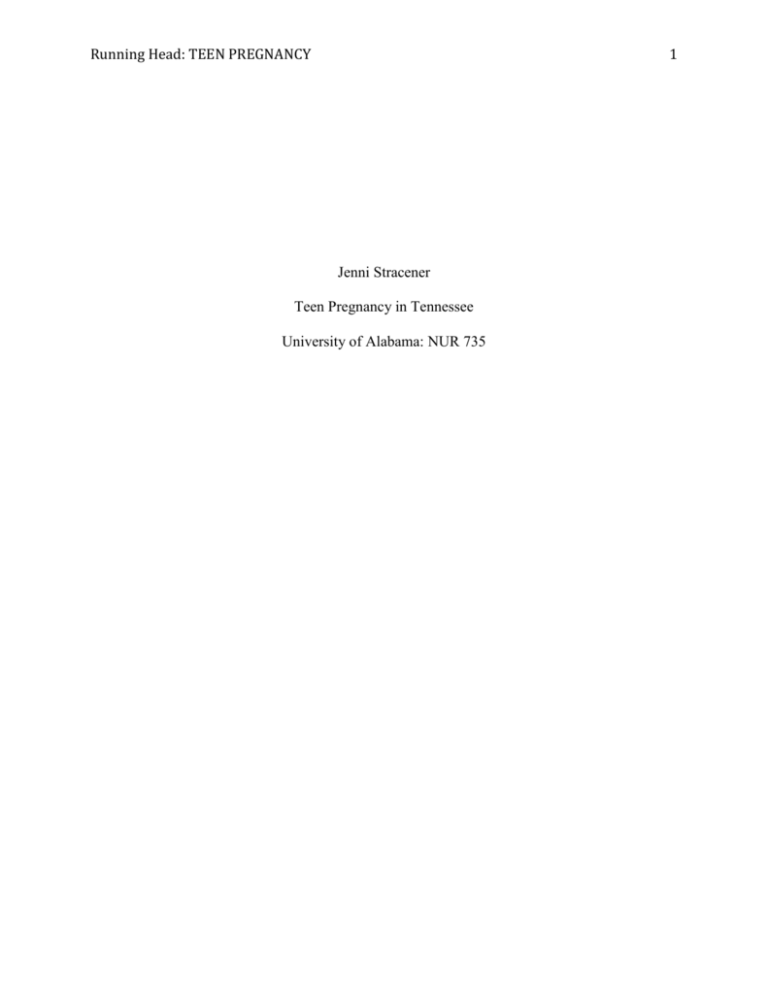
Running Head: TEEN PREGNANCY
1
Jenni Stracener
Teen Pregnancy in Tennessee
University of Alabama: NUR 735
2
TEEN PREGNANCY
Teen Pregnancy in Tennessee
Vulnerable populations can be defined by different characteristics. These can include
demographics, socioeconomic status, psychological issues, social health issues, physical
constraints, ethnic groups, gender, age and culture. While that is not an exhausted list, it covers
many aspects of vulnerability. The vulnerable population discussed in this paper is related to age:
female adolescents. The topic associated with this population will be teen pregnancy in the state
of Tennessee. Tennessee has consistently had one of the highest rates of teen pregnancy in the
United States.
Vulnerable Population
Teen Pregnancy. In 2012, there were 29.4 births for every 1,000 adolescent females
(ages 15-19) with the majority of teen births occurring outside of marriage. This rate is a decline
of six percent from 2011 and in general the teen birth rate has declined over the past twenty years
with the exception of 1991 (Martin, Hamilton, Osterman, Curtin & Mathews, 2013). According
to Salhu, August, Jeffers, Mbah, Alio and Berry (2011) the decline in teen pregnancy rates
nationally is due to contraceptive use and teens choosing to delay sexual activity. Even with
declining rates, the U.S. teen birth rate is higher than that of many other developed countries,
including Canada and the United Kingdom (Phipps & Nunes, 2012). According to the National
Campaign to Prevent Teen and Unplanned Pregnancy (2013), 52.4 % of teens have had sex
previously and 86.7% state that they have used contraception of some kind. Hispanics and
African Americans have the highest rates of teen pregnancies. Substantial geographic variation
also exists across the United States with teen birth rates lowest in the Northeast and highest the
South (Martin, Hamilton, Osterman, Curtin & Mathews, 2013). Studies have shown that less
that 5% of teens desire to get pregnant, while others have shown up to 15% of pregnancies are
TEEN PREGNANCY
3
planned (Phipps & Nunes, 2012). Repeat teen pregnancy is also a concern with nineteen percent
of teens having one child will have another pregnancy within twelve months and 38% within
twenty-four months (Salhu, August, Jeffers, Mbah, Alio & Berry, 2011).
Teen Pregnancy in Tennessee. Tennessee is ranked at 41 country wide for teen birth
rate and 38 for teen pregnancy rate. Tennessee ranks at 30 country wide for unplanned
pregnancies (The National Campaign to Prevent Teen and Unplanned Pregnancy, 2013). While
Tennessee has made great progress in teen pregnancy rates with a decrease of six percent since
2008, it still ranks amongst the top ten states for teen pregnancy. Tennessee has a teen pregnancy
rate of 40.8 per 1,000 with 87% of those pregnancies out of wedlock. Broken down by race and
ethnicity: 60% are non-Hispanic white, 31% are non-Hispanic black, 9% are Hispanic, and 1% is
Asian (Martin, Hamilton, Osterman, Curtin & Mathews, 2013). The cost in Tennessee for teen
childbearing was $272 million dollars in 2008 and $378 million is spent on unplanned
pregnancies (The National Campaign to Prevent Teen and Unplanned Pregnancy, 2013). The
Tennessee Department of Health cites multiple reasons for teen pregnancy in Tennessee: low
self-esteem, lack of family and community support, lack of involvement in school and
recreational activities or after school programs, lack of feeling connected to school, family and
community, use of alcohol and other drugs, lack of health education, lack of responsible adult
guidance and limited knowledge about sex and sexuality (TDH, 2013).
Vulnerable Population Conceptual Model
The Vulnerable Populations Model encompasses three main ideas: resource availability,
relative risk and health status. The model offers that there are interactions and relationship
between these ideas (Nyamathi, Koniak-Griffen & Greengold, 2007). Teen pregnancy risk
factors have consequences of adverse psychological and medical sequela for the teen mothers
TEEN PREGNANCY
4
and their children (Salhu, August, Jeffers, Mbah, Alio & Berry, 2011). The Vulnerable
Populations Model will be used to discuss how to improve these outcomes and prevent teen
pregnancy in Tennessee in each of the three ideas.
Resource Availability. Resource availability includes societal, economic and health
resources. These resources can be determined by the community and at the individual level.
Financial and geographic access is also a part of resource availability. According to Phipps and
Nunes (2012) eighty percent of teens had access to contraception before getting pregnant but
most did not use contraception when getting pregnant. The two most common reasons were “I
didn’t think I could get pregnant and I didn’t want to use birth control” (pg. 1825). The federal
Medicaid statute and the federal Title X Family Planning Program require access to confidential
reproductive health services to program-eligible adolescents who seek these services (ACOG,
2009).
In the state of Tennessee, teens over the age of fourteen are allowed to seek contraceptive
services without parental consent (ACOG, 2009). While teens do have access to confidential
reproductive services, the Tennessee Department of Health also recommends several programs
for the prevention of teen pregnancy. Abstinence education is taught through the public school
systems and resources are available to parents who request. The Black Health Initiative Programs
target African American and Hispanic teens. Target Prevention Programs offer intense eight to
twelve week programs for prevention. Community Prevention Initiative (CPI) Programs target
children up through age twelve who are at greatest risk for teen pregnancy. And finally, the state
recommends yearly Early Periodic Screening Diagnoses and Treatment (EPSDT) exams for all
children and adolescents, as these exams will focus on development and screenings for high-risk
TEEN PREGNANCY
5
problems such as teen pregnancy. Contraception and abstinence should be addressed during this
exam as well (TDH, 2013).
Relative Risk. Relative risk includes exposure to risk. Risk factors may be behavioral
such as lifestyle and choices, the utilization of health screening and health promotion services
and exposure to stressful events. There are some biological factors for teen pregnancy, but it is
not a gene that can be passed down. Minority teens have an increased rate of early sexual activity
and increased rates of teen pregnancy with Hispanic and African American teens having a rate
almost double that of whites (Talashek, Alba & Pate, 2006). Teens who have friends who are
sexually active and who have experience teen pregnancy are more likely to become pregnant
themselves. An even stronger correlation exists amongst siblings who are teen parents (East,
Khoo & Reyes, 2006). Even more risk factors for teen pregnancy include “history of mother’s
single parenting, family history of teenage parenting, family poverty and sibling pressure to be
sexually active” (Talashek, Alba & Patel, 2006, pg 188).
Age is a risk factor in itself. Teens are less likely to reach out for health promotion
services such as contraception. When surveyed, less than twenty percent of adolescents would
seek health care related to reproductive health if parental consent was required (Loxterman,
1997, ACOG 2009). The United States Supreme Court ruled in 1997 that minors have a right to
privacy in regards to the use of contraceptives. Confidentiality issues for minors are not covered
comprehensively through federal statutes and vary by state regulations. Most states decided that
protecting an adolescent’s confidentiality is more important than parental notification and control
in regards to contraception (Loxterman, 1997). Federal and state sex family planning policies
should be designed “to reduce sexual activity among teens, to provide education and tools for
TEEN PREGNANCY
6
safe sex, and to prevent unintended pregnancy and sexually transmitted diseases” (Yang &
Gaydos, 2010).
Tennessee has higher rates for students who have had sex at least one time, students who
had sex before age thirteen, students who have had sex with more than four persons and students
who drank or used drugs before sexual intercourse. Rates for condom use and birth control use
were close to the United States average (Martin, Hamilton, Osterman, Curtin & Mathews, 2013).
In the state of Tennessee, teens over the age of fourteen are able to access confidential health
services. These services include contraception, pregnancy testing, sexually transmitted infection
testing and counseling related to these items (ACOG, 2009). In contrast with previously
mentioned reasons for increased risk factors, a study by Talashek, Alba and Patel (2006) found
that church attendance and religious affiliation delayed sexual activity. Another protective factor
for teen pregnancy is family. Teens with parents who are considered strict have a lower rate of
pregnancy (East, Khoo & Reyes, 2006). Medical providers need to address these protective
factors with parents as part of the EPSDT visit.
Health Status. Health Status includes incidence, prevalence, morbidity, mortality and
widening gap. There are multiple risks associated with teen pregnancy: preterm birth, maternal
hypertension, low birth weight, and neonatal death. Health risks increase as the age of the mother
decreases (Phipps & Nunes, 2012). Gaps exist between African American and white teen
mothers: African American teens have a higher educational attainment than white teens. Teens
who become pregnant are more likely to use public assistance with African American teens most
likely to receive assistance and white teens less likely to receive assistance (Casares, Lahiff,
Eskenazi & Halpern-Felsher, 2010).
TEEN PREGNANCY
7
Tennessee has a repeat birth rate at 18% and a rate of low birth weight of 10.3%. While
Tennessee statistics have improved the rates still fall above average for rates of pregnancy and at
or below average for improvements in teen pregnancy rates. The abortion rate in Tennessee is
lower at 12 per 1,000 compared to the national average at 18 per 1,000. Ninety four percent of
teens in Tennessee are unwed (Martin, Hamilton, Osterman, Curtin, & Mathews, 2013).
Conclusion
There are multiple factors for protecting against teen pregnancy. Primary care physicians
including family physicians, pediatricians, and nurse practitioners typically provide care
adolescents and have a major role in initiating these protective factors (Salhu, August, Jeffers,
Mbah, Alio & Berry, 2011). Community-based programs and initiatives can help to address the
comprehensive needs of youth related to pregnancy (Salhu, August, Jeffers, Mbah, Alio & Berry,
2011) and creating screening tools for emotional readiness may be a good screening tool for
identifying and intervening in teen pregnancies (Phipps & Nunes, 2012). Effective teenage
pregnancy prevention programs include “abstinence or delay of sexual initiation, training in
decision-making and negotiation skills, and education on sexuality and contraception” (Salhu,
August, Jeffers, Mbah, Alio & Berry, 2011). While Tennessee has made great progress in teen
pregnancy, it still ranks amongst the top ten states. In the state of Tennessee, future policy and
interventions should focus on promoting access to contraceptive use and effective education
regarding abstinence and contraception. Contraception policies should keep in mind the needs of
adolescents from different races, socioeconomic status, cultural backgrounds and resources
available (Yang & Gaydos, 2010).
8
TEEN PREGNANCY
References
ACOG. (2009). Confidentiality in Adolescent Health Care. Retrieved from
http://www.acog.org/~/media/Departments/Adolescent%20Health%20Care/Teen%20Care%20T
ool%20Kit/ACOGConfidentiality.pdf?dmc=1&ts=20131104T2134436801
Casares, W. N., Lahiff, M., Eskenazi, B. and Halpern-Felsher, B. L. (2010). Unpredicted
trajectories: The relationship between race/ethnicity, pregnancy during adolescence, and young
women’s outcomes. Journal of Adolescent Health, 47(2): 143-150.
East, P. L., Khoo, S. T., & Reyes, B. T. (2006). Risk and protective factors predictive of
adolescent pregnancy: A longitudinal, prospective study. Applied and Developmental Science,
10(4): 188-199.
Loxterman, J. (1997). Adolescent Access to Confidential Health Services. Retrieved from
http://www.advocatesforyouth.org/publications/publications-a-z/516-adolescent-access-toconfidential-health-services
Martin, J. A., Hamilton, B. E., Osterman, M., Curtin, S. C., Mathews, T. J. (2013). Births:
Final data for 2012. National Vital Statistics Reports, (62)9: 1-87.
Nyamathi, A., Koniak-Griffin, D., & Greengold, B. A. (2007). Development of nursing
theory and science in vulnerable populations research. Annual Review of Nursing Research, 25,
27-48.
Phipps, M. G., & Nunes, A. P. (2012). Assessing pregnancy intention and associated risk
factors in pregnant adolescents. Maternal and Child Health Journal, 16: 1820 – 1827. DOI
10.1007/s10995-011-0928-0
TEEN PREGNANCY
9
Salhu, H. M., August, E. M., Jeffers, D. F., Mbah, A. K., Alio, A. P., and Berry, E.
(2011). Effectiveness of a federal healthy start program in reducing primary and repeat teen
pregnancies: Our experience over the decade. Journal of Pediatric and Adolescent Gynecology,
24(3), 153-160.
Santelli, J. (2010). State policy effects on teen fertility and evidence-based policies.
Journal of Adolescent Health, 46, 515-516.
Talashek, M. L., Alba, M. L., & Patel, A. (2006). Untangling the health disparities of teen
pregnancy. Journal for Specialists in pediatric Nursing, 11(1): 14-27.
Tennessee Department of Health. (2013). Racial and Ethnic Minority Tennesseans and
Adolescent Pregnancy. Retrieved from http://health.state.tn.us/dmhde/adpregnancy.shtml
The National Campaign to Prevent Teen and Unplanned Pregnancy. (2013). Tennessee
Data. Retrieved from http://thenationalcampaign.org/data/state/tennessee
Yang, Z. & Gaydos, L. M. (2010). Reasons for and challenges of recent increases in teen
birth rates: A study of family planning service policies and demographic changes at the state
level. Journal of Adolescent Health, 46, 517-524.





